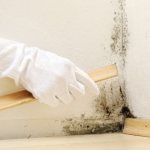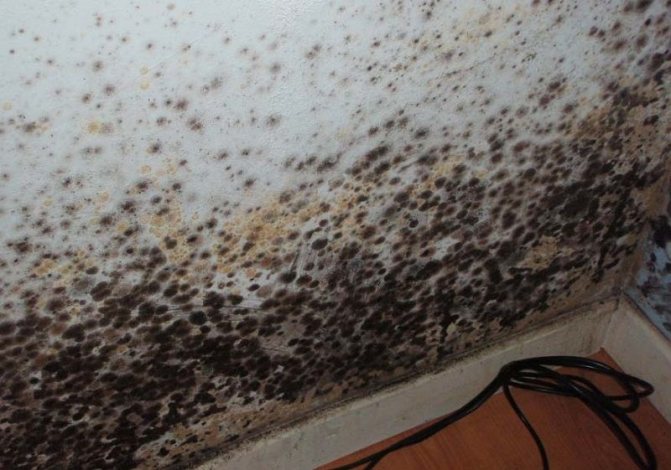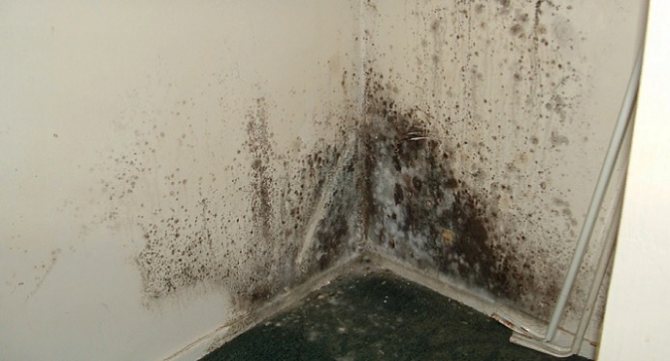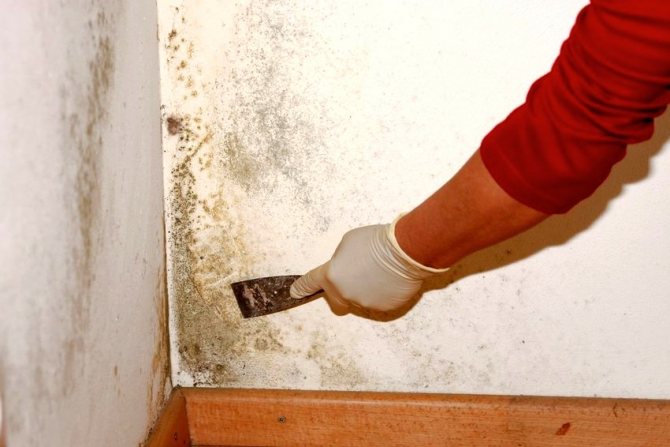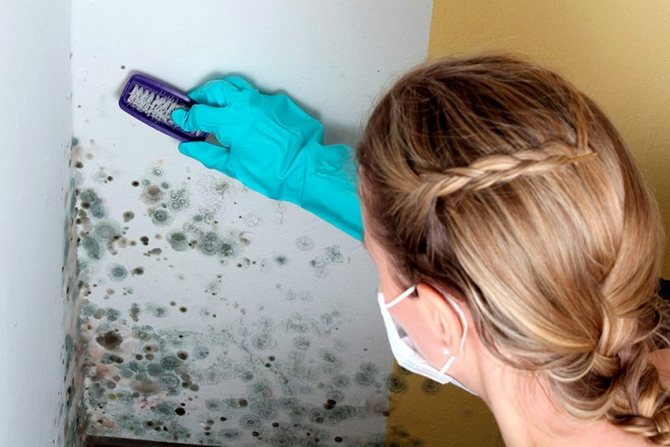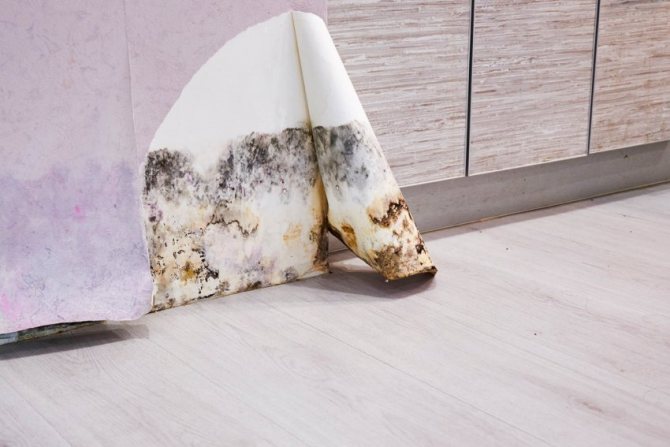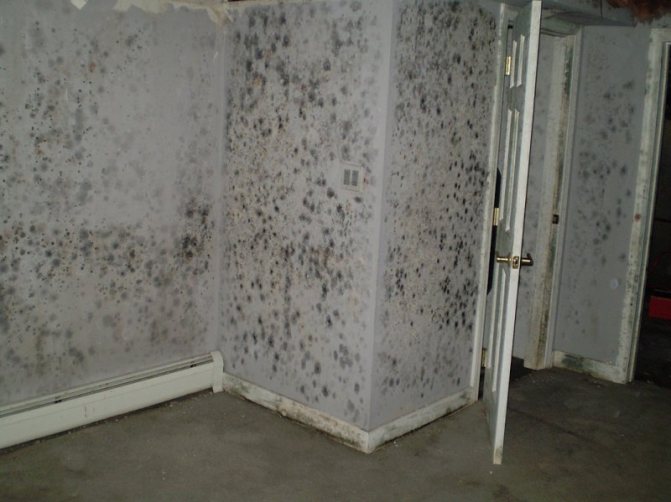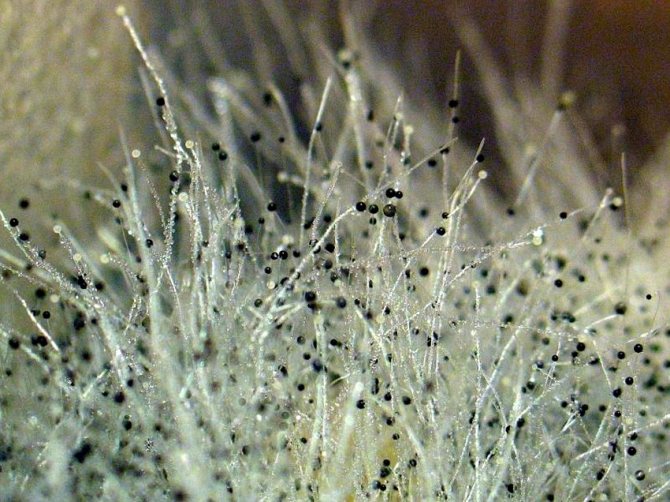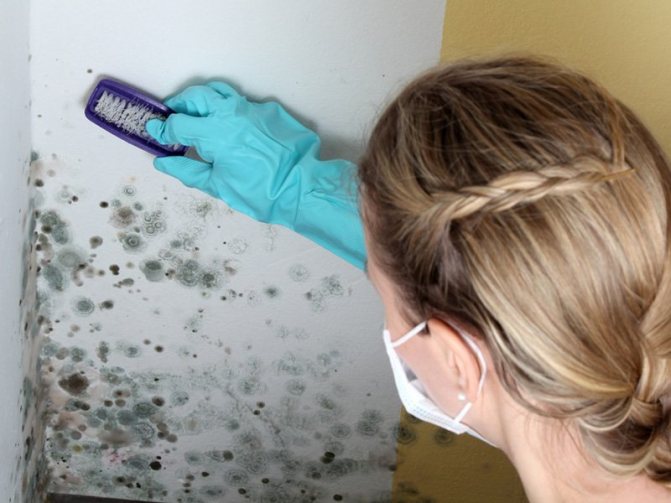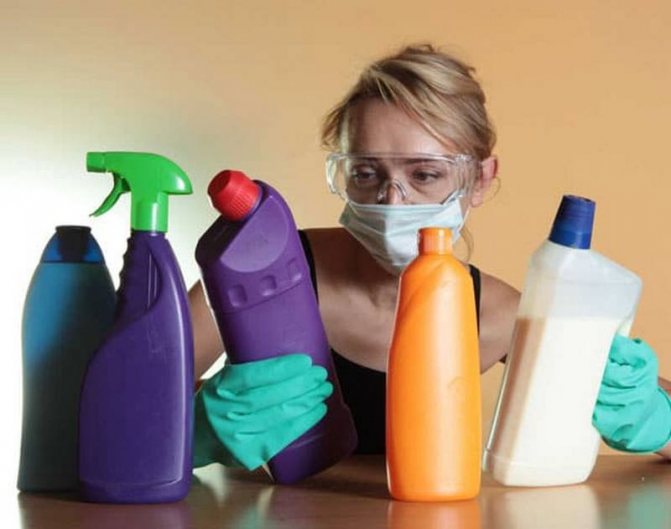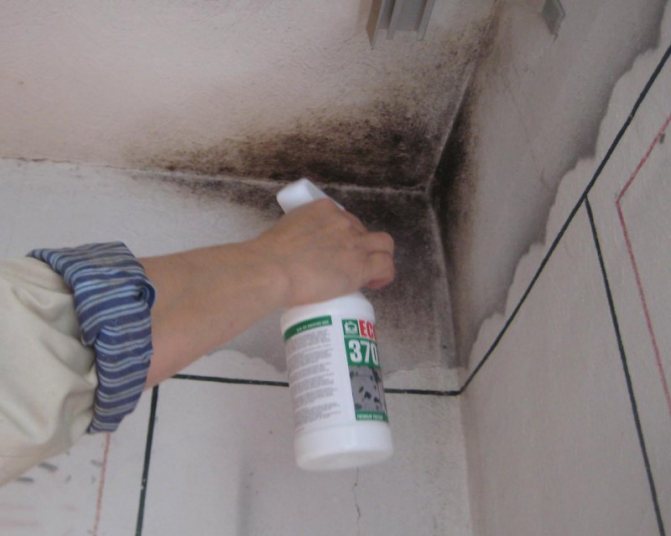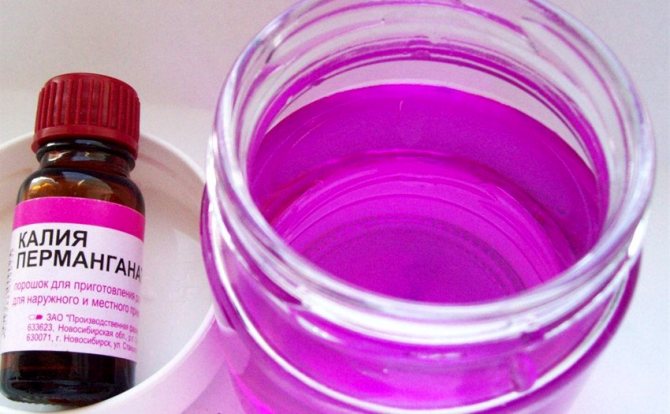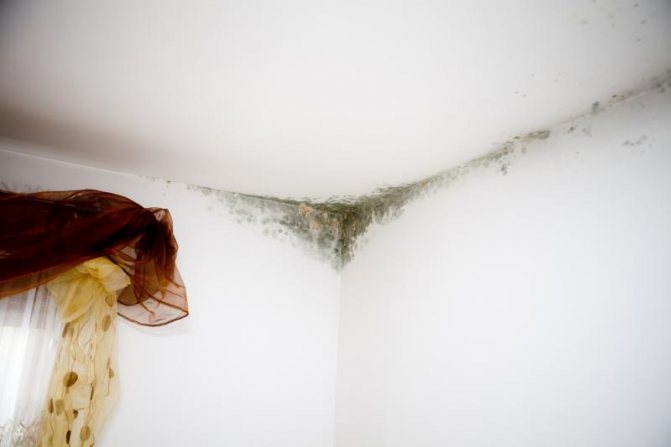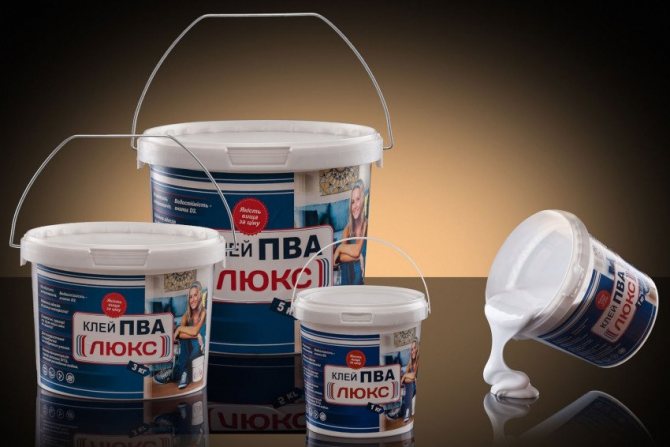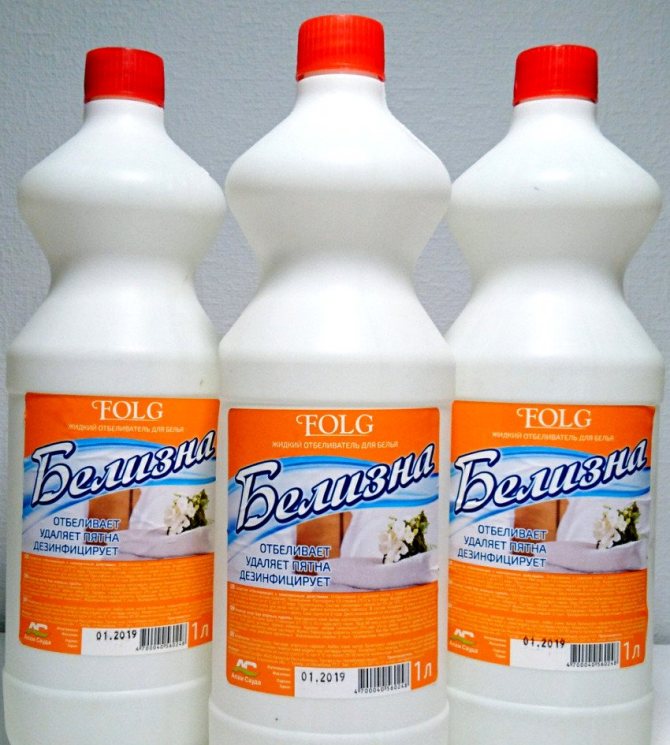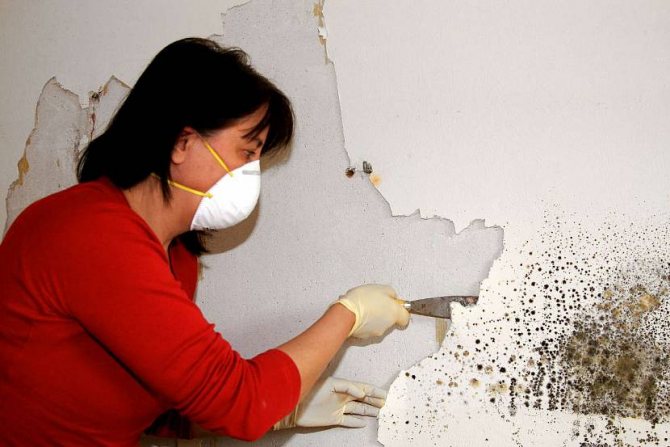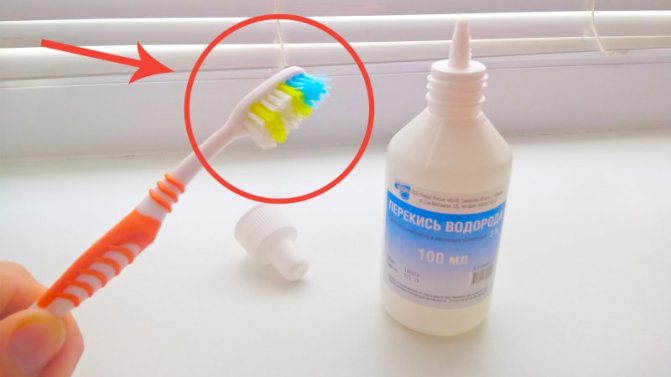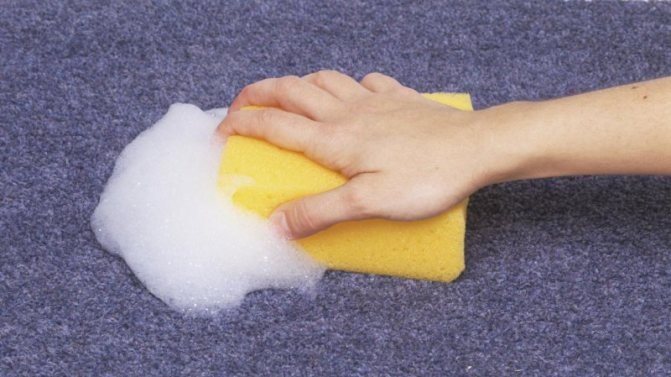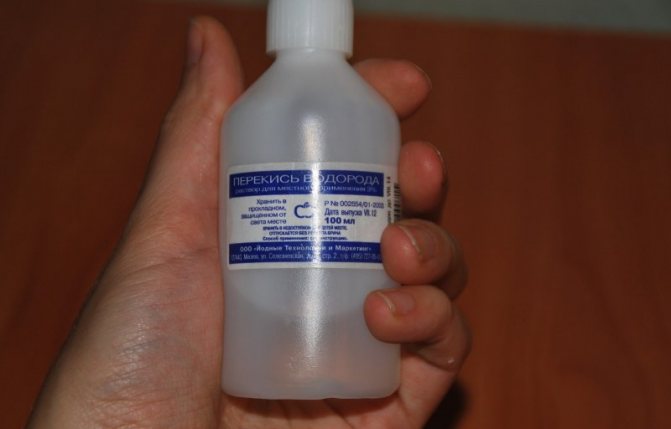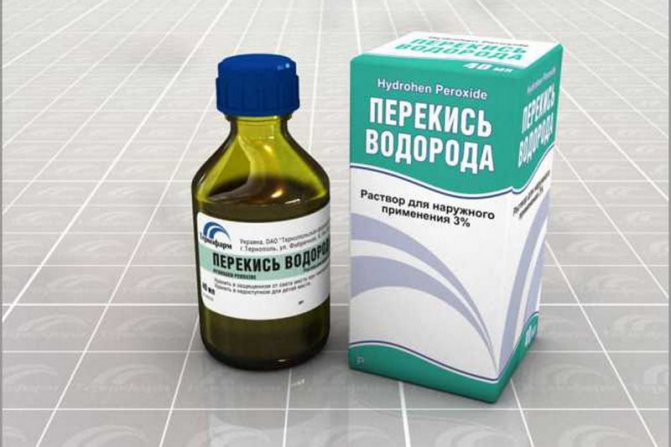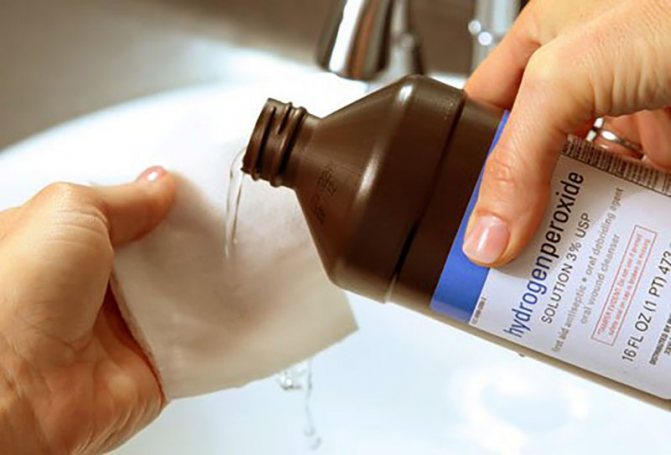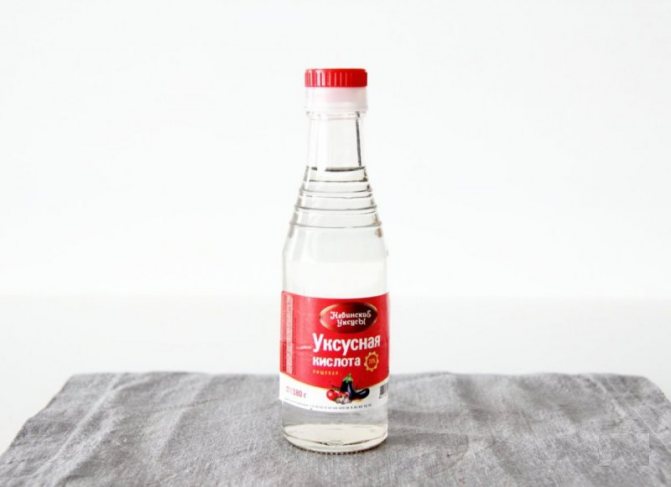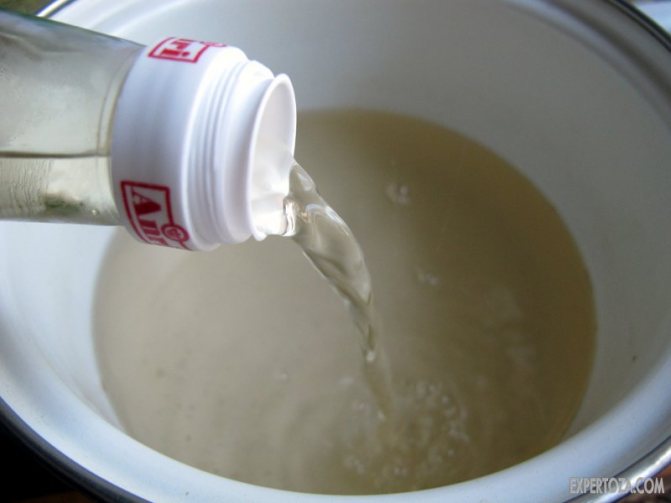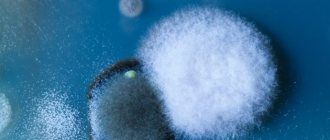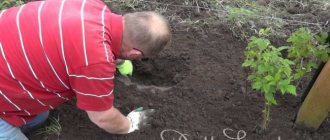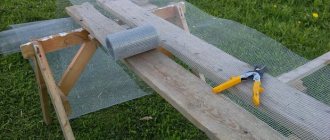Fungus on the walls of apartments and houses is a common phenomenon. Most often, the fungus appears on the ceiling and walls of a dwelling.
Mold eats deep into surfaces, spoiling their appearance and destroying them over time. However, it is not only the aesthetics of the home that suffer from mold.
Fungal mold under the plinus
The fungus is also very harmful to human health. Most often, it causes allergic reactions in apartment residents. When you find the first spots of mold, it is very important to start removing it right away.
We carry out an inspection

Examine the mold to get a better understanding of how to get rid of mold on the walls at home. Choose the best method.
If the mold on the walls of the house occupies the entire corner near the balcony or bathtub, then this is the place where a whole colony of microscopic fungi flourishes. Like ordinary fruiting mushrooms, they consist of a cap, a stem, and a mycelium.
Trying to wipe the stain with a rag, you will only be able to rip off the mushroom top, and the vegetative body, from a huge number of thin threads, you will leave unharmed. As a result, you will not get any positive effect from this procedure, the mold will again "please" the inhabitants of the room in a day. This will not help at all to solve the difficult question - how to remove mold from the wall in the house?
Variety of types of home mold
Before you destroy mold on the walls in the house, carefully and carefully examine the color of the stain - this can help you to recognize the strain of this smallest organism and very accurately establish an effective way to combat it. Brown or black powdery spots on the walls are caused by the following types of fungi:
- Ulocladium - they are common almost everywhere. Exclusively in Russia, there are about eight different species of them, some of them can have colors from orange to dark gray.
- Cladosporium - at first, a dull, undemanding mold fungus grows rapidly into a colony and changes its color to a very dark one. It is often found in dirty refrigerators, settles on flowers, likes to sit on the wallpaper.
- Aspergillus - often affects different foods. This mold fungus can live in very harsh environments, such as brickwork.
- Alternaria - mold on the walls of the house that loves water, found in the bathroom as well as in the kitchen.
Spotting and killing white mold
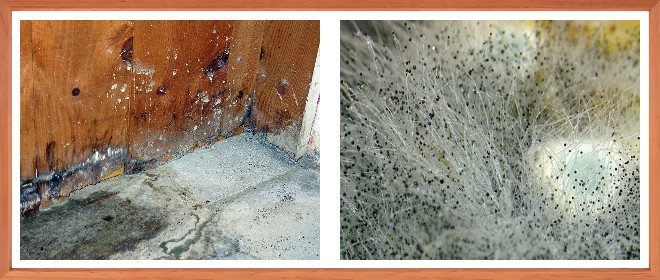

Mildew with white color on plaster in your home is more difficult to see. More often, it is better to judge the infection of an apartment with white mold by a white bloom on the ground in flowerpots with plants. Why white mold appears in the walls of the house, no one knows. The owners of such dwellings should be wary at the sight of suspicious white dots on the walls of an apartment or some other surface.
In a cellar or basement
Unlike other places in a country house, the appearance of fungus or mold in the basement can occur for the following reasons:
- Water formation around the foundation;
- Lack of ventilation in the room;
- Improper planning of the area around the house;
- Lack of insulation in the attic and walls, which leads to the formation of condensation and freezing of the enclosing structures.
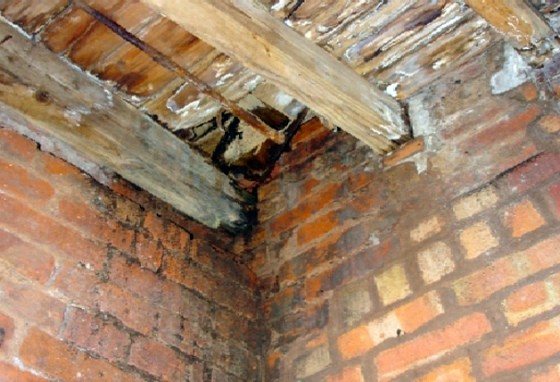

Mold in the basement
To fight the fungus in the basement, they begin with the insulation of the walls and floors.In old buildings, waterproofing must be restored. To prevent the appearance of fungus, you can periodically ventilate the room, which will help remove accumulated moisture. The second option for combating microscopic parasites is the injection of warm air into the cellar. The floor in this room is made of expanded clay or slag.
The surface of wooden products is covered with antiseptics in two or three layers, after which the material is thoroughly dried. It is better to replace the affected wood with a new one, but if there is no such possibility, then at the first signs of exposure to the fungus, the affected areas of the material are scraped off with a sharp knife. The lesions are treated with antiseptics or other chemicals.
Important! If you use chemicals to kill fungus or mold, use protective equipment (mask, respirator, gloves, goggles). Provide a constant supply of fresh air in the room.


Affected wood
Other ways to combat mold and mildew in your basement or cellar:
- Table salt is poured into a container placed on the floor, and then sulfuric acid is poured. This mixture will constantly evaporate. The released gases have a detrimental effect on the fungus;
- Using white moss powder, which acts as an adsorbent;
- Impregnation of affected walls with hydrochloric acid solution. In such a case, you need to take out all the vegetables and preservation from the cellar, and only after that you can begin to disinfect the room. Work must be carried out with thick rubber gloves;
- Installation of quicklime containers in the corner of the basement. This substance will pick up excess moisture from the air, depriving the mold of a favorable habitat;
- Mold is afraid of diesel fuel, acetic, citric and boric acid.
At home, there is mold on the walls - why?
If mold spores are everywhere, then why does this infection not attack every house or other room? Why does ugly mold appear on the walls in the house? The reasons are different. The point is the living conditions in a single place - for their own comfort, mankind has long been paying a certain price - proximity to fungi. Why do walls in a house get moldy? Because they are also satisfied with the average annual temperature and humidity in the room (18-23 degrees and 50-60% humidity). This is a very comfortable environment for mold to flourish in your home. That is why there are causes of mold on the walls in the house. The more humidity in the apartment, the more real is the possibility that mold will quickly appear on the walls of the house.
However, there are many houses in which there is regularly a fairly high humidity and at the same time mold does not grow on the walls of the house. Why do the walls in a house get moldy in some houses all the time and never in others?
Mold on the walls in the house - the reasons mainly lie in the violation of technologies in the field of construction, for example, improperly laid roofing cake, laying ineffective vapor barrier, and most importantly, poorly arranged ventilation.


Mold on the walls in the house grows due to the lack of a constant saturated inflow of fresh air masses of air, which increases the humidity of the air in the building.
If you eliminate this factor, then the question: "how to remove mold from the walls in the house?" will not torment anymore.
Types of fungi
There are four types of fungi, each of which is different and harmful in its own way. To understand what should be the treatment of walls in an apartment from fungus and mold, you first need to figure out what kind of harmful organisms you have got.
The options may be as follows.
Common mold
Such colonies grow on stones, concrete and wallpaper. Initially appears as small dots of gray, black, blue, or brown. Soon the dots are transformed into huge spots.Sometimes mold can be seen as glowing colonies of harmful microorganisms.
Important! If you run a problem, then the fungus will corrode building materials almost throughout their depth. ... Blue fungus
Blue fungus
It grows on a woody surface in the form of a gray or blue bloom. The danger of blue is that it significantly increases the moisture content of the tree, which soon leads to its destruction. Also, high humidity becomes a favorable environment for the formation of whole colonies of the blue stain fungus.
Important! Pine most often suffers from it.
.
Rotting fungus
This type of colonies is white and brown, also appears only on wood. When it appears, the walls turn gray, the material decomposes from the inside and loses its strength. There are several types of this rot:
- White rot - when it appears, the color of the tree practically does not change.
- When brown rot forms, stripes of yellow, brown and black appear.
As a result of the occurrence of such phenomena, the tree begins to bulge and split.
Important! The white mushroom house is the worst enemy of any wooden floor. In a month, he can completely ruin a wooden parquet with 40 mm thick boards. Previously, in case of infection with this mold, houses were simply burned so as not to infect the neighboring ones.
Efflorescence
Efflorescences can also be called very harmful. They spread to bricks and concrete. This fungus appears as a white salt deposit. Over time, it also penetrates deep into the materials and destroys them.
Now take a close look at the mold that has formed on your wall. Considering the above facts, determine which fungus has burst into your house. It is on its type that it depends on what kind of treatment the walls in the apartment will be from fungus and mold.
Mold is not safe for toddlers, the elderly, and the chronically ill
Asking the question - "how to remove mold on the wall in the house?", First think - what is the reason for the manifestation of mycelium in the house? In addition, try to calmly and soberly consider and assess the level of threat posed by the stains on the wall.
The unsafeness of molds is regularly written in newspapers, frightening documentaries are shot and they are discussed on special forums that mold is harmful on the walls in the house. All of them probably want people to think all the time - mold of the walls? How to remove mold on the wall in the house and what sad consequences can occur because of this. If we take on faith the information given there, then the conclusions can be drawn very deplorable. A person breathing spores of mold must be struck by various diseases - from asthma and allergies, and even a fatal ending. All of these publications have one goal - to get people to wonder - how to remove mold from the walls in the house? Many of the above consequences of contact with mold can be called pseudo-medical horror films. For example, the statement that mold can devour the human body from the inside is wrong. When a fungus breathes into a healthy human body, it often cannot withstand the cellular immune response and dies. People with strong immunity are also not afraid of inhaling pores. Therefore, you should not be afraid of her, but just ask yourself the question, how to remove mold in the house?
However, there is an amendment: the limiting concentration can be considered non-hazardous, - 500 spores / cubic meter. m.
An increase in people with allergies has been recorded in the world; mold for this category of patients is a very dangerous, strong natural allergen. Therefore, such people should seriously think about how to remove mold on the walls in their home so as not to risk their health.
Mold damage to humans and buildings
The main danger of mold is its spores, which spread through the air. When it comes into contact with human skin, mold can cause diseases:
- dermatitis of different nature;
- eczema;
- fungus of nails and hair.
If a person inhales spores, then this entails:
- runny nose;
- cough;
- conjunctivitis;
- allergy;
- bronchitis and asthma.
Through the respiratory tract and through skin cells, spores can enter the human blood, which is fraught with poisoning. Children are especially susceptible to this. In addition, people living in a moldy home often have headaches, dizziness, weakness, and nausea. Long-term exposure to moldy spores on a person leads to disorders of the musculoskeletal system, rheumatism and arthritis.
Why does mold often appear on the walls in the house?
As mentioned above, before declaring a war on mold, it is better to minimize or even remove the causes of mold on the walls in the house. The fungus grows and thrives in industrial buildings or residential buildings where there is high humidity and insufficient ventilation. When mold is on the walls in the house, the reason is most likely a blockage in the room. If you regularly ventilate the room, then this will remove one of the factors - why mold appears on the walls in the house. When it is not possible to do direct ventilation, it is necessary to establish the operation of the general ventilation system. In addition, it is useful to insulate the outer walls of the house in order to prevent them from freezing. This is especially true if you are the owner of a private home. Why is there mold on the walls in a private house? This question plagues many private sector owners.
Mold on the walls in the house - how to get rid of if the wall is covered with wallpaper
When a huge brown spot of mold spreads along the wall and you think that you can limit yourself to treating only this place where the wallpaper has turned black, then this is a mistake. Mold infects not only the wallpaper material itself, but also the walls under them, very deeply. To destroy such a fungus, it is not easy to clean the wallpaper, but to completely replace it.
After removing the top layer, you need to peel off the infected plaster with a metal brush. It will even be necessary to reach the brickwork until the wall is completely clean. This is the only way to get rid of it and then not think - how to get rid of mold on the walls for a long time at home? At the end of the work, the bare, cleaned wall is covered with a spray.
Spoiled aesthetics and more
Dark spots of the fungus will appear on the wallpaper in the future. Penetrating deep into the building materials, they begin their destructive activity. Dark spots on the wallpaper, gray-green stains on the walls, unpleasant slimy or shaggy surface of the affected areas are unlikely to add aesthetics to your interior.
At the same time, the neighborhood with such representatives also does not bode well for the health of the inhabitants of the apartment - allergies, asthma and other diseases can be caused by these tiny living organisms.
Their distinctive feature is their reproduction by spores. Spores spreading with dust throughout the house, these spores fill all its corners. Getting on the skin, mucous membranes or in the respiratory tract, they become a source of allergens and toxins.
We destroy the fungus with folk remedies
Mold on the walls in your home is a long-standing and common problem. By experience, people in ancient times came up with effective techniques to destroy the mold fungus on the wall. In those days, they also wondered why the walls in the house were often covered with mold, and looked for methods to deal with it. These popular mold control methods are very effective and safe when used at home.
How to remove mildew with whiteness from walls in your home


Quite a productive and uncomplicated method is considered to overcome the fungus on the wall with whiteness. For this procedure, only two things are needed: a washcloth to apply the composition to the surface and whiteness.
First, you need to apply a little whiteness to the washcloth, then carefully treat the infected area with it. Then you just need to wait a little, after 10 minutes the mold will begin to lose its color and completely disappear.
Mold on the wall in a private house - what to do? We use furacilin
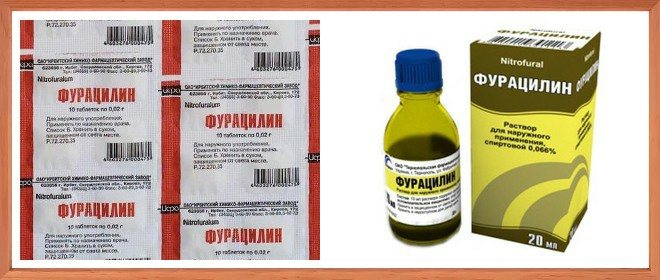

Treating moldy walls with furacilin often has a temporary effect. Therefore, it is better to do this every 3-4 months.
First you need to crush about ten pieces of furacilin tablets to a fine powder, then pour a glass of water. It turned out to be a simple and effective remedy for mold. The prepared preparation must be sprayed onto the infected walls with a spray bottle.
What is the most effective way to remove mold from the walls in your home? Copper sulfate
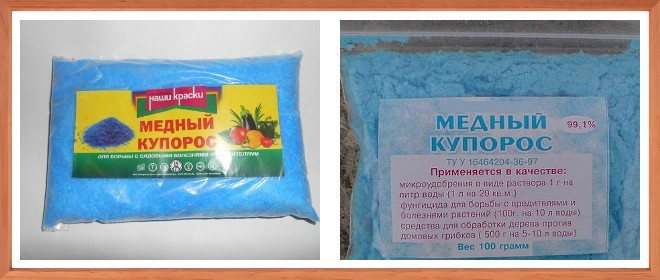

Copper sulfate is easy to buy at any pharmacy, it is sold in powder form. If you buy it, you can make a high-quality and very productive product against mold on the inner walls of the house.
To make the drug, you need to dissolve 100 grams of copper sulfate powder in ten liters of water. Then, like the other means described above, you should spray this mixture on the infected wall surface, or smear it with a sponge. For the best effect of this disinfecting mixture, carry out the procedure 2 times, after the wall, wipe it with a rag or rag dipped in a saturated soapy solution.
How to get rid of mold on the walls at home with vinegar?


Vinegar is very effective against various types of protozoan plants, such as mildew and mildew. Food vinegar is found in every home.
If you don't know how to remove mold on the walls of your home, a vinegar / hydrogen peroxide solution is best. Treatment of infected areas with these tools is affordable and simple. To prepare the mixture, you need to take a liter of water, 50 grams of peroxide, 150 grams of a bite, 25 grams of boric acid. Mix the components and before applying to the sites of infection, warm this mixture above 50 degrees to enhance the effect.
You can apply this mixture to the wall with a sponge or spray. Then you need to wait 1 hour and then wash it off with cold water. These procedures will help you forget for a long time the question - why does mold appear in the walls of the house?
Locations of mold
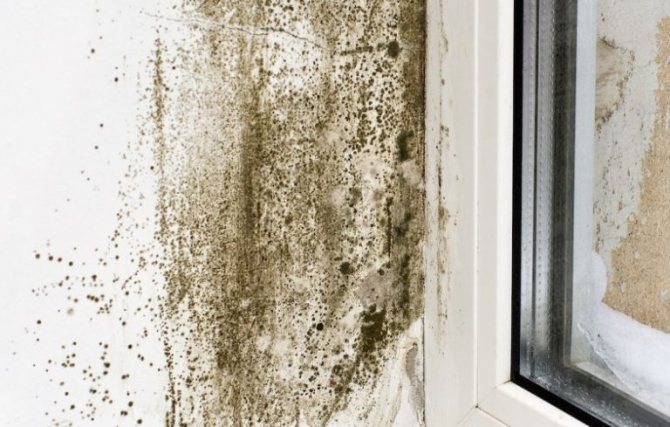

As a rule, mold appears in hard-to-reach places, combined with high humidity and low temperatures. These are places where the housewife rarely visits or cannot put things in order for a number of reasons. As a rule, black spots with a specific bloom appear in such places.
The main places of appearance of fungal colonies:
- On the walls from the inside, if there is no normal layer of insulation or the technology of house insulation is broken.
- At the joints of panels, as well as in the corners of rooms.
- In the areas of window sills.
- On the slopes.
- On wooden frames.
- On the tile joints in the bathrooms.
- On water pipes if condensation accumulates on them.
How to remove mold from a wall in your home with store-bought products
How to remove mold from the walls in the house? Go to a supermarket. Nowadays, home shops sell many different products that remove mold in the house. They all have a unique composition. It can be noted that any company that produces household chemicals produces its own line of preparations that destroy mold fungus.
For example, "Domestos" is now the leader in this area of the market and provides everyone who needs with the most advanced preparations for the destruction of mold.
Mold on the walls in the house - how to get rid of with building products
Where construction products are sold, you can also buy specialty mildew sprays. They are special in that they do not need to be diluted with water. Such agents are non-toxic and have excellent antifungal properties.
The most famous and effective building mixtures are:
- Dall,
- Olimp stop,
- Biotol.
Mold on the wall in a private house - what to do if nothing helps
Antiseptics prevent mold and kill it when it does. These are synthetic substances that disinfect any surface. After using an antiseptic, you can forget about mold for a long time. An antiseptic, in most cases, is a spray in a can. It must be sprayed on the place where the mold has appeared. Savo Przeciw Plesni and others are very well-known and productive antiseptics for solving the problem of how to remove black mold from the walls in the house.
The reasons
For complete removal, you need to know the reasons for the appearance of mold:
- Inefficient ventilation systems. Mold grows in places of stagnant air. With proper ventilation, the air in the room will circulate evenly. Moisture will go away, mold will not form in a dry place.
- Leakage of sewerage, water supply pipes.
- Failure to comply with construction technologies at the stage of laying the foundation. It is treated with water-repellent impregnation. Otherwise, water will penetrate inside, contribute to the development of mold.
- Low quality plastic windows made of inexpensive material. They have no ventilation. Moisture accumulates in the room in the form of condensation.
- Poor thermal insulation tends to shift the dew point. Condensation settles inside the apartment.
- Moisture penetration from the roof, basement;
- Poorly made waterproofing between the basement and the residential area.
These reasons provoke excessive moisture. Dampness, together with freezing temperatures, creates an excellent living environment for mold.
Detailed analysis - how to remove mold from the wall in the house
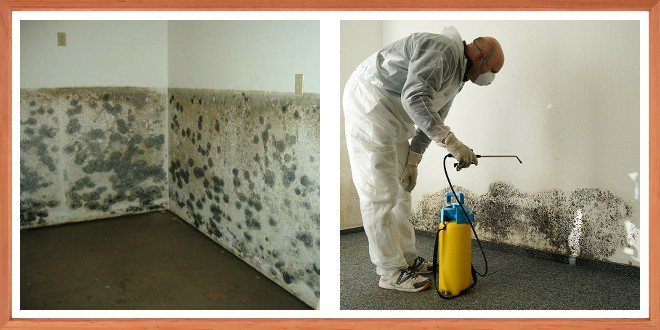

Before starting repair work, it is better to wet the surface of the wall with water to prevent spraying of the pores of the mold. In the process of work, it is better to protect yourself from inhaling mold particles by wearing a respirator or mask.
It is necessary to tear off the wallpaper or other finishing materials, then remove the layer of plaster infected with the fungus with a brush. It is best to then burn the infected fragments of wallpaper or plaster in a fire so that the question does not arise - how to remove the mold from the walls in the house, after a while. Next, we treat the wall with Himfre to remove the cement layer and open the pores.
We dilute the preparation with water, - Aseptic, and perform a thorough surface treatment with an antiseptic solution. Spread the resulting composition on the wall with a large roller or brush. It is necessary to cover the entire surface of the wall with an antiseptic, and not only where there is mold, so that later again not to solve the question - how to remove this black mold from the wall in the house? Aseptic primer will destroy all molds on the wall. It quite often restores the natural color of the surface. Adds strength and removes dust from the surface. Increases adhesion of gypsum and cement plasters, prolongs the durability of the finish. Preserves the vapor permeability of the bases.
If you are worried about why there is mold on the walls in a private house and how to get it out, then using the Aseptic drug will just help get rid of the fungus. After all the procedures, the walls are primed, whitewashed and the wallpaper is pasted again.
If it is a very difficult case, when the mold fungus has developed so deeply that it was able to penetrate into the inner layers of finishing materials and a full-fledged mycelium has already formed on them, then the external treatment will probably not bring the expected results. Then it is necessary to carry out a complete replacement of finishing materials or wallpaper.
Practical actions
If you find fungus or mold in your apartment, then do not hesitate - start fighting them as quickly as possible. Moreover, during the repair, it is better to do this even before gluing the wallpaper. The practical steps are as follows:
- First you need to remove the wallpaper from the wall.
- After that, it is necessary to remove the damaged layer of plaster using a spatula or a stiff brush.
- Your next action should be to carry out the treatment of the wall with a cleaning compound. This will help open the pores and remove the cement film.
- Next, you can proceed to preparing a solution based on a store-bought mold remover composition. It is best to use an antiseptic with an antifungal effect. They need to use a roller to process all surfaces without missing a single section. With the help of an antiseptic primer, you can easily return the wall to its usual appearance, and in addition, increase its strength characteristics and cleanse dirt particles. In addition, the composition will make the finish more durable.
- Then you need to prepare a dry waterproofing mixture. And also instead of it you can buy ready-made in the store. When the composition is ready for use, it is applied to the wall using a brush.
- Next, you need to treat the surface of the wall with a deep penetration primer.
- After that comes the turn of plastering and putty.
- The surfaces must then be primed again with a deep penetration primer.
- In the end, all that remains is to stick new wallpaper on the walls.
Remember that processing the walls before gluing the wallpaper is mandatory, otherwise all your efforts will be in vain.
It is necessary to act very quickly in order to prevent the spread of microorganisms to new areas. Dealing with mold and mildew can be quite simple if you start acting at the moment of its first appearance and use highly effective drugs. One of these are antiseptics, which, due to their antimicrobial effect, can quickly eliminate any types of microorganisms.
But at the same time, along with them, you can use a lot of improvised means for treating mold, which can also be of good help in the fight against microorganisms. However, the best way to prevent mold from growing in an apartment is to regularly take preventive measures. It is necessary to ensure that the humidity of the room remains at a relatively low level, and for this, all rooms must be regularly ventilated.
How to remove mold with baking soda
Baking soda will not harm either people or pets, processing with the composition can be done safely.
Dissolve a teaspoon of baking soda in 200 ml of water and proceed to surface treatment by pouring the product into a spray bottle. One hour after applying the solution, wash the affected areas with water, however, do not completely wash out the baking soda, it can protect the coatings from the reappearance of the fungus.
To do this, we perform the following work: ✓ We remove the wallpaper, if any. ✓ Determine the depth of the lesion. Note that a fungus can easily penetrate the plaster to a brick or concrete wall in a year. ✓ Therefore, it is possible and necessary to remove the plaster layer from the wall. ✓ We remove . ✓ Thoroughly remove plaque.
You can use a metal brush for this. If there is no such brush, then you can use coarse sandpaper or a scraper. Important! ✓ First you need to moisten the wall surfaces with water. Water prevents the spread of fungus spores through the air throughout the room during cleaning. ✓ We remove everything under a brush. ✓ Dry the walls with a fan heater or production hair dryer. ✓ We treat the cleaned surface with chemistry.
How to get rid of the effects of the fungus?
There is an opinion, which is probably based on our own bad experience, that the fungus cannot be defeated. For example, some people try to get rid of the problem by insulating the walls. But this approach not only does not help, but exacerbates the situation, since the fungus feels great in the heat-insulating material.
Or, spotlights are powerful and bright lamps that try to "dry the mold". Fungal spores quickly adapt to new conditions and easily tolerate "drying".Waterproofing over the mold, unfortunately, won't help either. Water will find an opportunity to bypass all the tricks and the mold will "bloom" again.
When you have taken all the measures to eliminate the cause of the appearance of the fungus, you can proceed to the next stage - removing the mold and drying the wall, after which it will be possible to start repairs. First, all old coatings are manually removed from the walls, and then the wall is thoroughly dried with soffits, a construction hairdryer or electric heaters.
The best option for such a procedure would be infrared heaters, the radiation of which penetrates deep into the surface and dries it as efficiently as possible. If the case is "difficult", then it is necessary to remove the layer of plaster, and drill holes in the places of the greatest spread of the fungus to see the depth of the lesion. And do not forget that all the described procedures must be carried out in a respirator so that dust and fungal spores do not enter the body.
The video below shows one of the simplest options for getting rid of mold with a cheap tool.
Wall treatment with antiseptics
The drugs listed above can be used both to combat an already existing foci of mold spread, and as a preventive measure. All antifungal wall treatment is performed in several stages.
Before applying the antiseptic to the wall, it should be properly prepared. First of all, it is necessary to remove all finishing from the affected areas - old wallpaper, plaster, putty up to the bare wall.
All coatings must be stripped off before processing.
To remove the old finish, you can use any tools at hand: a spatula, hammer, chisel, old hatchet, etc. To make the old wallpaper easier to come off, they should be thoroughly moistened with warm water and left for half an hour.
The plaster infused with mycelium is also completely dismantled and disposed of. After the wall is completely free of interior decoration, you should carefully inspect it. If it is damp to the touch, you will need to thoroughly dry it with a heat gun or a hair dryer.
A mixture of hydrogen peroxide, boric acid and vinegar
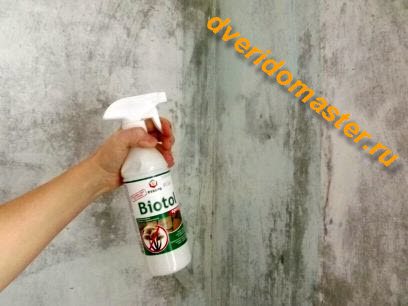

The substance is best used in its pure form by spraying on the affected areas with a spray bottle. Rub the cleaner over the wall with a rag and let sit for an hour. Wash the surfaces with clean water.
To avoid the reappearance of the fungus, carry out a preventive treatment with vinegar every 7-10 days.
For 4 parts of water, you need to take 2 parts of vinegar and boric acid and 1 part of peroxide 3%. The resulting solution is sprayed onto a previously cleaned surface and remains for an hour. Then it is washed off with warm water.

